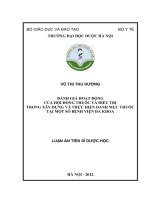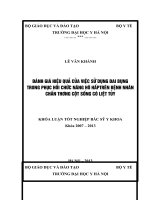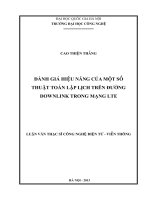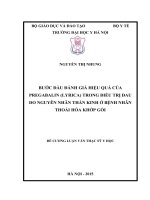Đánh giá hiệu quả của phác đồ điều trị dựa vào theo dõi oxy tổ chức não trong chấn thương sọ não nặng
Bạn đang xem bản rút gọn của tài liệu. Xem và tải ngay bản đầy đủ của tài liệu tại đây (198.97 KB, 8 trang )
��������������������������������������������������������������������������������������������������������������������������������������������������������������������������������������������������������������������������������������������������������������������������������������������������������������������������������������������������������������������������������������������������������������������������������������������������������������������������������������������������������������������������������������������������������������������������������������������������������������������������������������������������������������������������������������������������������������������������������������������������������������������������������������������������������������������������������������������������������������������������������������������������������������������������������������������������������������������������������������������������������������������������������������������������������������������������������������������������������������������������������������������������������������������������������������������������������������������������������������������������������������������������������������������������������������������������������������������������������������������������������������������������������������������������������������������������������������������������������������������������������������������������������������������������������������������������������������������������������������������������������������������������������������������������������������������������������������������������������������������������������������������������������������������������������������������������������������������������������������������������������������������������������������������������������������������������������������������������������������������������������������������������������������������������������������������������������������������������������������������������������������������������������������������������������������������������������������������������������������������������������������������������������������������������������������������������������������������������������������������������������������������������������������������������������������������������������������������������������������������������������������������������������������������������������������������������������������������������������������������������������������������������������������������������������������������������������������������������������������������������������������������������������������������������������������������������������������������������������������������������������������������������������������������������������������������������������������������������������������������������������������������������������������������������������������������������������������������������������������������������������������������������������������������������������������������������������������������������������������������������������������������������������������������������������������������������������������������������������������������������������������������������������������������������������������������������������������������������������������������������������������������������������������������������������������������������������������������������������������������������������������������������������������������������������������������������������������������������������������������������������������������������������������������������������������������������������������������������������������������������������������������������������������������������������������������������������������������������������������������������������������������������������������������������������������������������������������������������������������������������������������������������������������������������������������������������������������������������������������������������������������������������������������������������������������������������������������������������������������������������������������������������������������������������������������������������������������������������������������������������������������������������������������������������������������������������������������������������������������������������������������������������������������������������������������������������������������������������������������������������������������������������������������������������������������������������������������������������������������������������������������������������������������������������������������������������������������������������������������������������������������������������������������������������������������������������������������������������������������������������������������������������������������������������������������������������������������������������������������������������������������������������������������������������������������������������������������������������������������������������������������������������������������������������������������������������������������������������������������������������������������������������������������������������������������������������������������������������������������������������������������������������������������������������������������������������������������������������������������������������������������������������������������������������������������������������������������������������������������������������������������������������������������������������������������������������������������������������������������������������������������������������������������������������������������������������������������������������������������������������������������������������������������������������������������������������������������������������������������������������������������������������������������������������������������������������������������������������������������������������������������������������������������������������������������������������������������������������������������������������������������������������������������������������������������������������������������������������������������������������������������������������������������������������������������������������������������������������������������������������������������������������������������������������������������������������������������������������������������������������������������������������������������������������������������������������������������������������������������������������������������������������������������������������������������������������������������������������������������������������������������������������������������������������������������������������������������������������������������������������������������������������������������������������������������������������������������������������������������������������������������������������������������������������������������������������������������������������������������������������������������������������������������������������������������������������������������������������������������������������������������������������������������������������������������������������������������������������������������������������������������������������������������������������������������������������������������������������������������������������������������������������������������������������������������������������������������������������������������������������������������������������������������������������������������������������������������������������������������������������������������������������������������������������������������������������������������������������������������������������������������������������������������������������������������������������������������������������������������������������������������������������������������������������������������������������������������������������������������������������������������������������������������������������������������������������������������������������������������������������������������������������������������������������������������������������������������������������������������������������������������������������������������������������������������������������������������������������������������������������������������������������������������������������������������������������������������������������������������������������������������������������������������������������������������������������������������������������������������������������������������������������������������������������������������������������������������������������������������������������������������������������������������������������������������������������������������������������������������������������������������������������������������������������������������������������������������������������������������������������������������������������������������������������������������������������������������������������������������������������������������������������������������������������������������������������������������������������������������������������������������������������������������������������������������������������������������������������������������������������������������������������������������������������������������������������������������������������������������������������������������������������������������������������������������������������������������������������������������������������������������������������������������������������������������������������������������������������������������������������������������������������������������������������������������������������������������������������������������������������������������������������������������������������������������������������������������������������������������������������������������������������������������������������������������������������������������������������������������������������������������������������������������������������������������������������������������������������������������������������������������������������������������������������������������������������������������������������������������������������������������������������������������������������������������������������������������������������������������������������������������������������������������������������������������������������������������������������������������������������������������������������������������������������������������������������������������������������������������������������������������������������������������������������������������������������������������������������������������������������������������������������������������������������������������������������������������������������������������������������������������������������������������������������������������������������������������������������������������������������������������������������������������������������������������������������������������������������������������������������������������������������������������������������������������������������������������������������������������������������������������������������������������������������������������������������������������������������������������������������������������������������������������������������������������������������������������������������������������������������������������������������������������������������������������������������������������������������������������������������������������������������������������������������������������������������������������������������������������������������������������������������������������������������������������������������������������������������������������������������������������������������������������������������������������������������������������������������������������������������������������������������������������������������������������������������������������������������������������������������������������������������������������������������������������������������������������������������������������������������������������������������������������������������������������������������������������������������������������������������������������������������������������������������������������������������������������������������������������������������������������������������������������������������������������������������������������������������������������������������������������������������������������������������������������������������������������������������������������������������������������������������������������������������������������������������������������������������������������������������������������������������������������������������������������������������������������������������������������������������������������������������������������������������������������������������������������������������������������������������������������������������������������������������������������������������������������������������������������������������������������������������������������������������������������������������������������������������������������������������������������������������������������������������������������������������������������������������������������������������������������������������������������������������������������������������������������������������������������������������������������������������������������������������������������������������������������������������������������������������������������������������������������������������������������������������������������������������������������������������������������������������������������������������������������������������������������������������������������������������������������������������������������������������������������������������������������������������������������������������������������������������������������������������������������������������������������������������������������������������������������������������������������������������������������������������������������������������������������������������������������������������������������������������������������������������������������������������������������������������������������������������������������������������������������������������������������������������������������������������������������������������������������������������������������������������������������������������������������������������������������������������������������������������������������������������������������������������������������������������������������������������������������������������������������������������������������������������������������������������������������������������������������������������������������������������������������������������������������������������������������������������������������������������������������������������������������������������������������������������������������������������������������������������������������������������������������������������������������������������������������������������������������������������������������������������������������������������������������������������������������������������������������������������������������������������������������������������������������������������������������������������������������������������������������������������������������������������������������������������������������������������������������������������������������������������������������������������������������������������������������������������������������������������������������������������������������������������������������������������������������������������������������������������������������������������������������������������������������������������������������������������������������������������������������������������������������������������������������������������������������������������������������������������������������������������������������������������������������������������������������������������������������������������������������������������������������������������������������������������������������������������������������������������������������������������������������������������������������������������������������������������������������������������������������������������������������������������������������������������������������������������������������������������������������������������������������������������������������������������������������������������������������������������������������������������������������������������������������������������������������������������������������������������������������������������������������������������������������������������������������������������������������������������������������������������������������������������������������������������������������������������������������������������������������������������������������������������������������������������������������������������������������������������������������������������������������������������������������������������������������������������������������������������������������������������������������������������������������������������������������������������������������������������������������������������������������������������������������������������������������������������������������������������������������������������������������������������������������������������������������������������������������������������������������������������������������������������������������������������������������������������������������������������������������������������������������������������������������������������������������������������������������������������������������������������������������������������������������������������������������������������������������������������������������������������������������������������������������������������������������������������������������������������������������������������������������������������������������������������������������������������������������������������������������������������������������������������������������������������������������������������������������������������������������������������������������������������������������������������������������������������������������������������������������������������������������������������������������������������������������������������������������������������������������������������������������������������������������������������������������������������������������������������������������������������������������������������������������������������������������������������������������������������������������������������������������������������������������������������������������������������������������������������������������������������������������������������������������������������������������������������������������������������������������������������������������������������������������������������������������������������������������������������������������������������������������������������������������������������������������������������������������������������������������������������������������������������������������������������������������������������������������������������������������������������������������������������������������������������������������������������������������������������������������������������������������������������������������������������������������������������������������������������������������������������������������������������������������������������������������������������������������������������������������������������������������������������������������������������������������������������������������������������������������������������������������������������������������������������������������������������������������������������������������������������������������������������������������������������������������������������������������������������������������������������������������������������������������������������������������������������������������������������������������������������������hời gian thở máy, thời gian
nằm hồi sức, điểm GCS khi ra khỏi phòng hồi
sức không có sự khác biệt có ý nghĩa thống
kê giữa 2 nhóm. Như vậy, nghiên cứu của
1. Van den Brink W.A (1998). Monitoring
brain oxygen tension in severe head injury:
The Rotterdam experience. Acta Neurochir, 71
(Suppl), 190 - 194.
2. Gopinath SP Robertson (1994).
Jugular venous desaturation and outcome
after
head
injury.
J
Neurol
Neurosurg
chúng tôi cho thấy vẫn chưa thực sự khẳng
Psychiatry, 57, 717 - 723.
định được ưu thế của việc điều trị dựa vào
PbtO2 so với nhóm điều trị theo hướng dẫn
3. Le Roux P (1997). Cerebral
arteriovenous difference of oxygen: A
predictor of cerebral infarction and outcome in
của áp lực nội sọ trong việc cải thiện kết quả
điều trị. Kết quả nghiên cứu này cũng giống
như kết quả của các tác giả trên thế giới [13;
14]. Hơn nữa, với mức độ tổn thương ban đầu
nặng nề (GCS < 6) ở bệnh nhân chấn thương
sọ não nặng thì sự khác biệt về kết quả điều
trị đôi khi là rất nhỏ, do đó đòi hỏi cần phải có
một nghiên cứu so sánh ngẫu nhiên với số
lượng bệnh nhân lớn hơn nữa mới cho phép
làm sáng tỏ mức độ tin cậy của biện pháp
điều trị dựa vào PbO2/áp lực nội sọ đối với kết
quả điều trị.
V. KẾT LUẬN
Phác đồ điều trị trên hướng dẫn dựa vào
severe head injury. J Neurosurg, 87, 1 - 8.
4. Stiefel M.F (2006). Conventional
neurocritical care does not ensure cerebral
oxygenation after traumatic brain injury. J
Neurosurg, 105, 568 - 575.
5. Menon DK, (2004). Diffusion limited
oxygen delivery following head injury. Crit
Care Med, 32, 1384 - 1390.
6. Stein S.C (2004). Association between
intravascular microthrombosis and cerebral
ischemia
in
traumatic
brain
injury.
Neurosurgery, 54, 687 - 689.
7.Mamarou A, (2006). Predominance of
cellular edema in traumatic brain swelling in
PbtO2 có xu hướng làm giảm tỉ lệ tử vong
và tăng tỉ lệ bệnh nhân có kết quả điều trị tốt
patients
sau 6 tháng so với phác đồ điều trị theo
hướng dẫn dựa vào áp lực nội sọ. Tuy nhiên,
8. Maragos WF, (2004). Mitochondrial
uncoupling as a potential therapeutic target in
sự khác biệt này chưa có ý nghĩa thống kê.
acute
Lời cảm ơn
Nhóm nghiên cứu xin chân thành cảm ơn
các bệnh nhân và gia đình bệnh nhân, các
TCNCYH 99 (1) - 2016
with
severe
head
injuries.
J
Neurosurg, 104, 720 - 730.
central
nervous
system
injury.
J
Neurochem, 91, 257 - 262.
9. Van den Brink W.A (2000). Brain
oxygen tension in severe head injury.
Neurosurg, 46, 868 - 876.
79
TẠP CHÍ NGHIÊN CỨU Y HỌC
10. Stiefel M.F, (2005). Reduced mortality
rate in patients with severe traumatic brain
injury treated with brain tissue oxygen
monitoring. J Neurosurg, 103, 805 - 811.
11. Wilensky E.M,Gracias V, (2009).
Brain tissue oxygen and outcome after severe
traumatic brain injury: A systematic review.
Crit Care Med, 37, 2057 - 2063.
12. Foundation Brain Trauma (2007).
Guidelines for the management of severe
traumatic brain injury. J Neurotrauma, 24(1),
S1 – S106.
13. Spiotta A.M, Stiefel M.F et al (2010).
Brain tissue oxygen-directed management and
outcome in patients with severe traumatic
brain injury. J Neurosurg, 113, 571 - 580.
14. Nangunoori R, Maloney-Wilensky E
et al (2012). Brain tissue oxygen-based
therapy and outcome after severe traumatic
brain injury: a systematic literature review.
Neurocrit Care, 17, 131 - 138.
Summary
ASSESS THE EFFECTS OF BRAIN TISSUE OXYGEN GUIDED
TREATMENT IN SEVERE TRAUMATIC BRAIN INJURY
The aim of this study was to determine the effect of brain tissue oxygen-guided treatment on
outcome of patients with severe traumatic brain injury (TBI). 76 patients with severe TBI (Glasgow
Coma Scale [GCS] score ≤ 8) were selected from 5/2013 to 12/2014 in ICU - Vietduc hospital and
divided into two groups: Brain tissue oxygenation ([PbtO2] was measured in the first group, (PbtO2
group) while the second group was being monitored by intracranial pressure ([ICP] - ICP group).
All patients were treated according to the common protocol to maintain goal which are PbtO2 > 20
mmHg and/or ICP < 20 mmHg. The outcomes were assessed by mortality rates, durations of
mechanical ventilation, lengths of stay in ICU, Glasgow Outcome Scale (GOS) after 6 months
post TBI. Age, median Injury Severe Score (ISS), admission GCS score, duration inserted
catheter neuromonitoring after accident, hypotension and hypoxia rates on admission were not
different between two groups. The mean daily value of ICP and cerebral perfusion pressure (CPP)
measured between the two groups was similar. PbtO2 group have lower mortality rates, higher
rate of good outcome (13.1% and 34.2%) after 6 months post TBI compared to the ICP group
(21.1% and 26.3%) but the differences were not statistically significant (p > 0.1). In conclusion,
Brain tissue oxygen monitor-based treatment guidelines have trend to reduce mortality rate and
increase the proportion of patients with good outcomes after 6 months post TBI. To show a clear
beneficial effect of PbtO2 guided management on outcome, a larger randomised trial needs to be
studied.
Keywords: brain tissue oxygen pressure, PbtO2, severe traumatic brain injury, intracerebral pressure, ICP
80
TCNCYH 99 (1) - 2016









